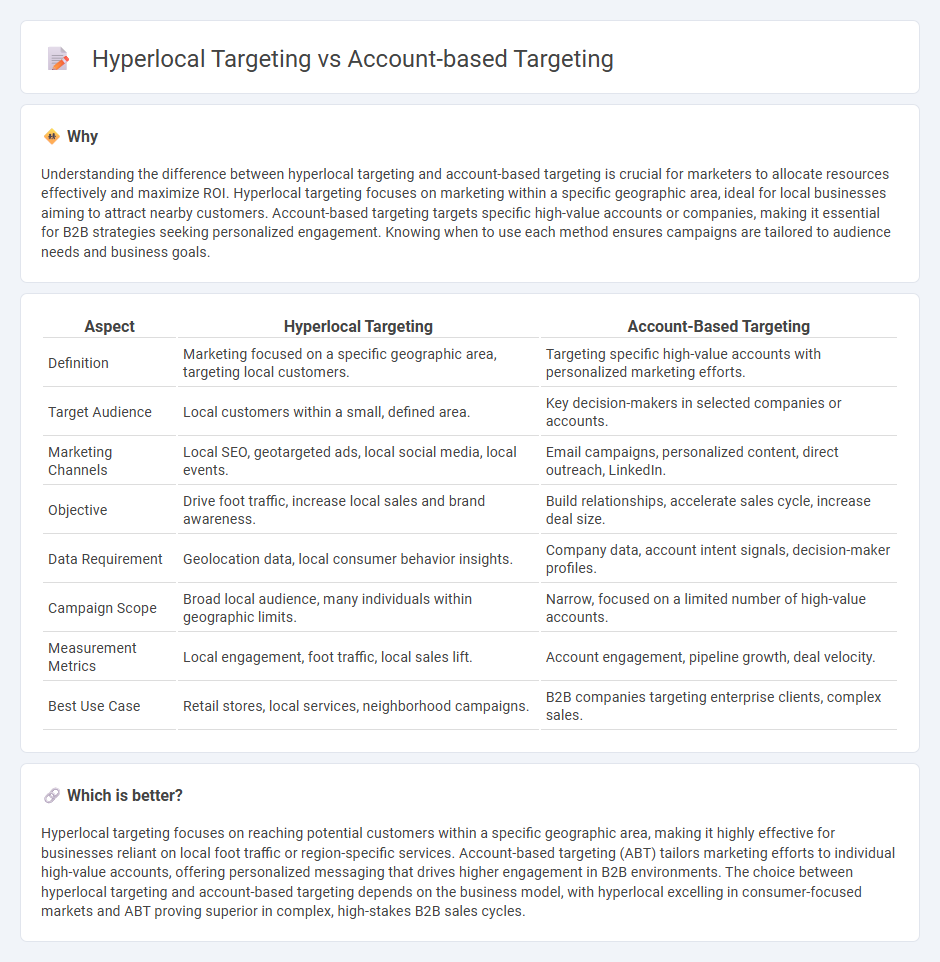
Hyperlocal targeting focuses on reaching customers within a specific geographic area, using location data and local preferences to tailor marketing campaigns, enhancing relevance and engagement. Account-based targeting zeroes in on individual companies or key accounts, delivering personalized content and offers designed to meet the specific needs of high-value clients, boosting conversion rates and ROI. Explore the strategies and benefits of hyperlocal versus account-based targeting to optimize your marketing efforts effectively.
Why it is important
Understanding the difference between hyperlocal targeting and account-based targeting is crucial for marketers to allocate resources effectively and maximize ROI. Hyperlocal targeting focuses on marketing within a specific geographic area, ideal for local businesses aiming to attract nearby customers. Account-based targeting targets specific high-value accounts or companies, making it essential for B2B strategies seeking personalized engagement. Knowing when to use each method ensures campaigns are tailored to audience needs and business goals.
Comparison Table
| Aspect | Hyperlocal Targeting | Account-Based Targeting |
|---|---|---|
| Definition | Marketing focused on a specific geographic area, targeting local customers. | Targeting specific high-value accounts with personalized marketing efforts. |
| Target Audience | Local customers within a small, defined area. | Key decision-makers in selected companies or accounts. |
| Marketing Channels | Local SEO, geotargeted ads, local social media, local events. | Email campaigns, personalized content, direct outreach, LinkedIn. |
| Objective | Drive foot traffic, increase local sales and brand awareness. | Build relationships, accelerate sales cycle, increase deal size. |
| Data Requirement | Geolocation data, local consumer behavior insights. | Company data, account intent signals, decision-maker profiles. |
| Campaign Scope | Broad local audience, many individuals within geographic limits. | Narrow, focused on a limited number of high-value accounts. |
| Measurement Metrics | Local engagement, foot traffic, local sales lift. | Account engagement, pipeline growth, deal velocity. |
| Best Use Case | Retail stores, local services, neighborhood campaigns. | B2B companies targeting enterprise clients, complex sales. |
Which is better?
Hyperlocal targeting focuses on reaching potential customers within a specific geographic area, making it highly effective for businesses reliant on local foot traffic or region-specific services. Account-based targeting (ABT) tailors marketing efforts to individual high-value accounts, offering personalized messaging that drives higher engagement in B2B environments. The choice between hyperlocal targeting and account-based targeting depends on the business model, with hyperlocal excelling in consumer-focused markets and ABT proving superior in complex, high-stakes B2B sales cycles.
Connection
Hyperlocal targeting and account-based targeting (ABT) are connected through their focus on precision and personalization in marketing strategies. Hyperlocal targeting narrows marketing efforts to specific geographic locations, allowing brands to tailor messages to local consumer behaviors and preferences. When combined with ABT, which targets high-value accounts with customized campaigns, marketers can deliver highly relevant content to individual businesses or decision-makers within precise local markets, enhancing engagement and conversion rates.
Key Terms
Segmentation
Account-based targeting segments audiences by identifying and targeting specific businesses or clients based on firmographics, purchase history, and decision-maker roles. Hyperlocal targeting narrows segmentation to a geographic micro-area, using data like GPS location, local events, and neighborhood demographics for precise outreach. Explore the nuances of both strategies to optimize your marketing segmentation.
Personalization
Account-based targeting (ABT) personalizes marketing efforts by focusing on specific high-value accounts, delivering tailored messages based on detailed company data and buyer personas. Hyperlocal targeting zeroes in on a precise geographic area, using location-based data to customize offers and content that resonate with local consumer behaviors and preferences. Explore the key differences and benefits to enhance your personalization strategy effectively.
Location Data
Account-based targeting leverages precise company data and firmographics to engage specific business accounts, while hyperlocal targeting focuses intensely on capturing consumer behavior within narrowly defined geographic areas using granular location data. Location data in hyperlocal targeting includes GPS coordinates, IP addresses, and Wi-Fi signals to deliver timely, contextually relevant ads to users in immediate proximity, enhancing engagement through spatial relevance. Explore how integrating both strategies can maximize marketing precision and drive higher conversion rates.
Source and External Links
4 Benefits of Account-Based Marketing for Programmatic - StackAdapt - Account-based targeting is a precise, measurable, and scalable advertising approach that uses firmographic and persona-level data to target specific accounts and key decision-makers, enhancing campaign cost-effectiveness and ROI.
How to Use Account Based Marketing to Win High-Value Deals - Account-based targeting focuses sales and marketing efforts on a defined set of high-value prospects with personalized campaigns, prioritizing quality over quantity to boost revenue and business growth.
Account-Based Marketing (ABM) | Salesforce US - ABM tools enable targeted selection, personalized outreach, and multi-channel engagement of key accounts, integrating CRM data to align marketing and sales efforts and optimize campaign performance.
 dowidth.com
dowidth.com